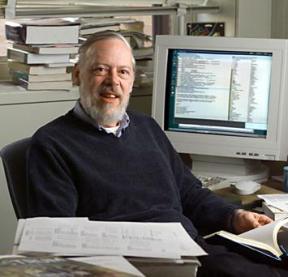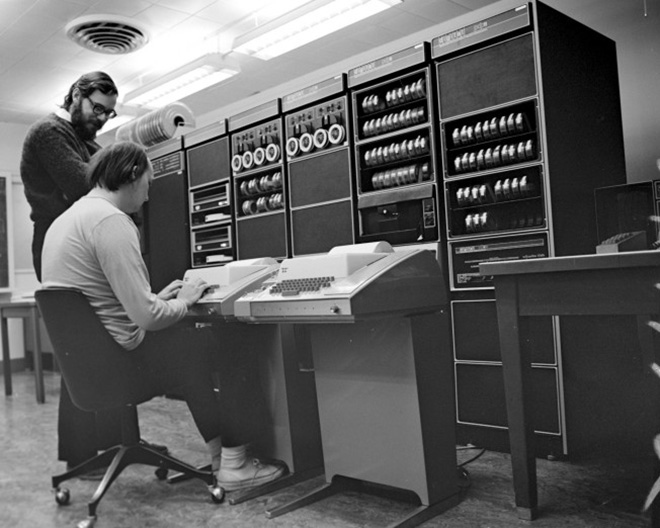 After a long illness, Dennis Ritchie, father of Unix and an esteemed computer scientist, died last weekend at the age of 70.
After a long illness, Dennis Ritchie, father of Unix and an esteemed computer scientist, died last weekend at the age of 70.
Oct 15, 2011 Rip Empson is a writer at TechCrunch.
UNIX (operating system), a word coined ca 1970 by Ritchie's co-worker Brian Kernighan was a pun on Multics, an early operating system developed at MIT
Intro
Many of the ideas for C (language) came from the original FORTRAN compiler (click here re its inventor), the first high-level language, which apparently took 18 man years to develop at IBM back in 1957. To this C added Algol-like extensions not present in FORTRAN.
At the time storage on hard disk drives was prohibitively expensive, and input and storage of program libraries (called subroutines) was via punched cards and magnetic tape. AT&T Teletype Corporation produced teleprinters with a paper tape punch and reader.
The road to the first C compiler then took a number of steps.
Note that in the use of these languages, stored subroutines in Fortran (also COBOL and Basic) became functions in C, and then methods in C++, Java, etc.
For those interested, click here for an article on modern day Intel x86 Disassembly of C compiled code.
Main
 After a long illness, Dennis Ritchie, father of Unix and an esteemed computer scientist, died last weekend at the age of 70.
After a long illness, Dennis Ritchie, father of Unix and an esteemed computer scientist, died last weekend at the age of 70.
Ritchie, also known as "dmr", is best known for creating the C programming language as well as being instrumental in the development of UNIX along with Ken Thompson. Ritchie spent most of his career at Bell Labs, which at the time of his joining in 1967, was one of the largest phone providers in the U.S. and had one of the most well-known research labs in operation.
Working alongside Thompson (who had written B) at Bell in the late sixties, the two men set out to develop a more efficient operating system for the up-and-coming minicomputer, resulting in the release of Unix (running on a DEC PDP-11) in 1971.
Though Unix was cheap and compatible with just about any machine, allowing users to install a variety of software systems, the OS was written in assembly language, meaning that it had a small vocabulary and suffered in relation to memory.
By 1973, Ritchie and Thompson had rewritten Unix in C, developing C's syntax, functionality and beyond, to give the language the ability to program the operating system. The kernel was published in the same year.
Today, C remains the second most popular programming language in the world (or at least the language in which the second most lines of code have been written), and ushered in C++ and Java; while the pair's work on Unix led to, among other things, Linus Torvalds' Linux. The work has without a doubt made Ritchie one of the most important, if not under-recognized, engineers of the modern era.
His work, specifically in relation to UNIX, led to him becoming a joint recipient of the Turing Award with Ken Thompson in 1983, as well as a recipient of the National Medal of Technology in 1998 from then-president Bill Clinton.
By Cade Metz, Wired Enterprise

The tributes to Dennis Ritchie won't match the river of praise that spilled out over the web after the death of Steve Jobs. But they should.
And then some.
"When Steve Jobs died last week, there was a huge outcry, and that was very moving and justified. But Dennis had a bigger effect, and the public doesn't even know who he is," says Rob Pike, the programming legend and current Googler who spent 20 years working across the hall from Ritchie at the famed Bell Labs.
On Wednesday evening, with a post to Google+, Pike announced that Ritchie had died at his home in New Jersey over the weekend after a long illness, and though the response from hardcore techies was immense, the collective eulogy from the web at large doesn't quite do justice to Ritchie's sweeping influence on the modern world. Dennis Ritchie is the father of the C programming language, and with fellow Bell Labs researcher Ken Thompson, he used C to build UNIX, the operating system that so much of the world is built on including the Apple empire overseen by Steve Jobs.
"Pretty much everything on the web uses those two things: C and UNIX," Pike tells Wired. "The browsers are written in C. The UNIX kernel that pretty much the entire Internet runs on is written in C. Web servers are written in C, and if they're not, they're written in Java or C++, which are C derivatives, or Python or Ruby, which are implemented in C. And all of the network hardware running these programs I can almost guarantee were written in C.
"It's really hard to overstate how much of the modern information economy is built on the work Dennis did."
Even Windows was once written in C, he adds, and UNIX underpins both Mac OS X, Apple's desktop operating system, and iOS, which runs the iPhone and the iPad. "Jobs was the king of the visible, and Ritchie is the king of what is largely invisible," says Martin Rinard, professor of electrical engineering and computer science at MIT and a member of the Computer Science and Artificial Intelligence Laboratory.
"Jobs' genius is that he builds these products that people really like to use because he has taste and can build things that people really find compelling. Ritchie built things that technologists were able to use to build core infrastructure that people don't necessarily see much anymore, but they use everyday."
From B to C
Dennis Ritchie built C because he and Ken Thompson needed a better way to build UNIX. The original UNIX kernel was written in assembly language, but they soon decided they needed a "higher level" language, something that would give them more control over all the data that spanned the OS. Around 1970, they tried building a second version with Fortran, but this didn't quite cut it, and Ritchie proposed a new language based on a Thompson creation known as B.
Depending on which legend you believe, B was named either for Thompson's wife Bonnie or BCPL, a language developed at Cambridge in the mid-60s. Whatever the case, B (a stripped down version of BCPL) then begat C.
B was an interpreted language. "The B compiler on the PDP-7 did not generate machine instructions, but instead generated 'threaded code' (code which consisted entirely of calls to subroutines)." These were then executed by an intermediate piece of software running atop the CPU. C on the other hand was designed to be a fully compiled language, translating the source code down to its final machine code, before being loaded and executed on the CPU. It would give Ritchie and Thompson the flexibility they needed, but at the same time, it would be fast.
That first version of the language wasn't all that different from C as we know it today though it was a tad simpler. It offered full data structures and "types" for defining variables, and this is what Richie and Thompson used to build their new UNIX kernel. "They built C to write a program," says Pike, who would join Bell Labs 10 years later. "And the program they wanted to write was the UNIX kernel."
Ritchie's running joke was that C had "the power of assembly language and the convenience of … assembly language." In other words, he acknowledged that C was a less-than-gorgeous creation that still ran very close to the hardware. Today, it's considered a low-level language, not high. But Ritchie's joke didn't quite do justice to the new language. In offering true data structures, it operated at a level that was just high enough.
"When you're writing a large program and that's what UNIX was you have to manage the interactions between all sorts of different components: all the users, the file system, the disks, the program execution, and in order to manage that effectively, you need to have a good representation of the information you're working with. That's what we call data structures," Pike says.
"To write a kernel without a data structure and have it be as consistent and graceful as UNIX would have been a much, much harder challenge. They needed a way to group all that data together, and they didn't have that with Fortran."
At the time, it was an unusual way to write an operating system, and having that intermediate code is what allowed Ritchie and Thompson to eventually port the OS to other platforms, which they did in the late 70s. "That opened the floodgates for UNIX running everywhere," Pike says. "It was all made possible by C."
Apple, Microsoft, and Beyond
At the same time, C forged its own way in the world, moving from Bell Labs to the world's universities and to Microsoft, the breakout software company of the 1980s. "The development of the C programming language was a huge step forward and was the right middle ground … C struck exactly the right balance, to let you write at a high level and be much more productive, but when you needed to, you could control exactly what happened," says Bill Dally, chief scientist of NVIDIA and Bell Professor of Engineering at Stanford. "[It] set the tone for the way that programming was done for several decades."
As Pike points out, the data structures that Richie built into C eventually gave rise to the object-oriented paradigm used by modern languages such as C++ and Java.
The revolution began in 1973, when Ritchie published his research paper on the language, and five years later, he and colleague Brian Kernighan released the definitive C book: The C Programming Language. Kernighan had written the early tutorials for the language, and at some point, he "twisted Dennis' arm" into writing a book with him.
Pike read the book while still an undergraduate at the University of Toronto, picking it up one afternoon while heading home for a sick day. "That reference manual is a model of clarity and readability compared to later manuals. It is justifiably a classic," he says. "I read it while sick in bed, and it made me forget that I was sick."
Like many university students, Pike had already started using the language. It had spread across college campuses because Bell Labs started giving away the UNIX source code. Among so many other things, the operating system gave rise to the modern open source movement. Pike isn't overstating it when he says the influence of Ritchie's work can't be overstated, and though Ritchie received the Turing Award in 1983 and the National Medal of Technology in 1998, he still hasn't gotten his due.
As Kernighan and Pike describe him, Ritchie was an unusually private person. "I worked across the hall from him for more than 20 years, and yet I feel like I don't knew him all that well," Pike says. But this doesn't quite explain his low profile. Steve Jobs was a private person, but his insistence on privacy only fuelled the cult of personality that surrounded him.
Ritchie lived in a very different time and worked in a very different environment than someone like Jobs. It only makes sense that he wouldn't get his due. But those who matter understand the mark he left. "There's that line from Newton about standing on the shoulders of giants," says Kernighan. "We're all standing on Dennis' shoulders."
Additional reporting by Jon Stokes.